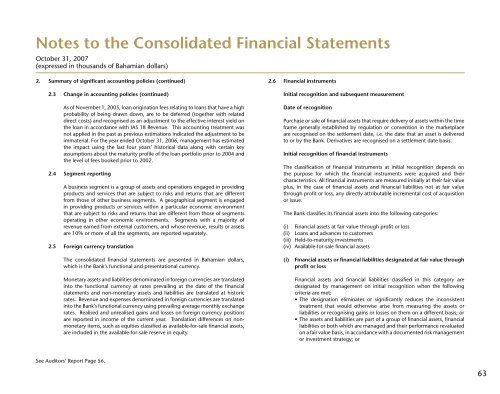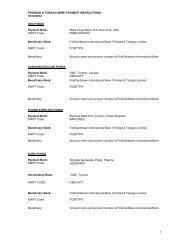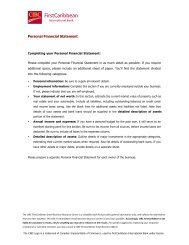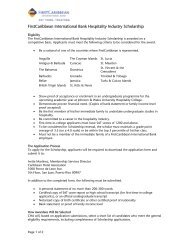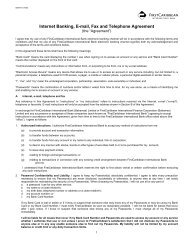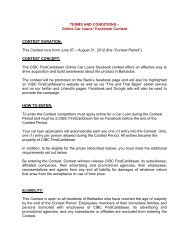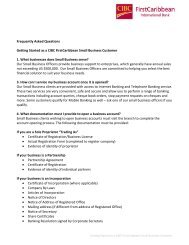Bahamas - FirstCaribbean International Bank
Bahamas - FirstCaribbean International Bank
Bahamas - FirstCaribbean International Bank
Create successful ePaper yourself
Turn your PDF publications into a flip-book with our unique Google optimized e-Paper software.
Notes to the Consolidated Financial Statements<br />
October 31, 2007<br />
(expressed in thousands of Bahamian dollars)<br />
2. Summary of significant accounting policies (continued)<br />
2.3 Change in accounting policies (continued)<br />
As of November 1, 2005, loan origination fees relating to loans that have a high<br />
probability of being drawn down, are to be deferred (together with related<br />
direct costs) and recognised as an adjustment to the effective interest yield on<br />
the loan in accordance with IAS 18 Revenue. This accounting treatment was<br />
not applied in the past as previous estimations indicated the adjustment to be<br />
immaterial. For the year ended October 31, 2006, management has estimated<br />
the impact using the last four years’ historical data along with certain key<br />
assumptions about the maturity profile of the loan portfolio prior to 2004 and<br />
the level of fees booked prior to 2002.<br />
2.4 Segment reporting<br />
A business segment is a group of assets and operations engaged in providing<br />
products and services that are subject to risks and returns that are different<br />
from those of other business segments. A geographical segment is engaged<br />
in providing products or services within a particular economic environment<br />
that are subject to risks and returns that are different from those of segments<br />
operating in other economic environments. Segments with a majority of<br />
revenue earned from external customers, and whose revenue, results or assets<br />
are 10% or more of all the segments, are reported separately.<br />
2.5 Foreign currency translation<br />
2.6 Financial instruments<br />
Initial recognition and subsequent measurement<br />
Date of recognition<br />
Purchase or sale of financial assets that require delivery of assets within the time<br />
frame generally established by regulation or convention in the marketplace<br />
are recognised on the settlement date, i.e. the date that an asset is delivered<br />
to or by the <strong>Bank</strong>. Derivatives are recognised on a settlement date basis.<br />
Initial recognition of financial instruments<br />
The classification of financial instruments at initial recognition depends on<br />
the purpose for which the financial instruments were acquired and their<br />
characteristics. All financial instruments are measured initially at their fair value<br />
plus, in the case of financial assets and financial liabilities not at fair value<br />
through profit or loss, any directly attributable incremental cost of acquisition<br />
or issue.<br />
The <strong>Bank</strong> classifies its financial assets into the following categories:<br />
(i) Financial assets at fair value through profit or loss<br />
(ii) Loans and advances to customers<br />
(iii) Held-to-maturity investments<br />
(iv) Available-for-sale financial assets<br />
The consolidated financial statements are presented in Bahamian dollars,<br />
which is the <strong>Bank</strong>’s functional and presentational currency.<br />
Monetary assets and liabilities denominated in foreign currencies are translated<br />
into the functional currency at rates prevailing at the date of the financial<br />
statements and non-monetary assets and liabilities are translated at historic<br />
rates. Revenue and expenses denominated in foreign currencies are translated<br />
into the <strong>Bank</strong>’s functional currency using prevailing average monthly exchange<br />
rates. Realised and unrealised gains and losses on foreign currency positions<br />
are reported in income of the current year. Translation differences on nonmonetary<br />
items, such as equities classified as available-for-sale financial assets,<br />
are included in the available-for-sale reserve in equity.<br />
(i)<br />
Financial assets or financial liabilities designated at fair value through<br />
profit or loss<br />
Financial assets and financial liabilities classified in this category are<br />
designated by management on initial recognition when the following<br />
criteria are met:<br />
• The designation eliminates or significantly reduces the inconsistent<br />
treatment that would otherwise arise from measuring the assets or<br />
liabilities or recognising gains or losses on them on a different basis; or<br />
• The assets and liabilities are part of a group of financial assets, financial<br />
liabilities or both which are managed and their performance revaluated<br />
on a fair value basis, in accordance with a documented risk management<br />
or investment strategy; or<br />
See Auditors’ Report Page 56.<br />
63


